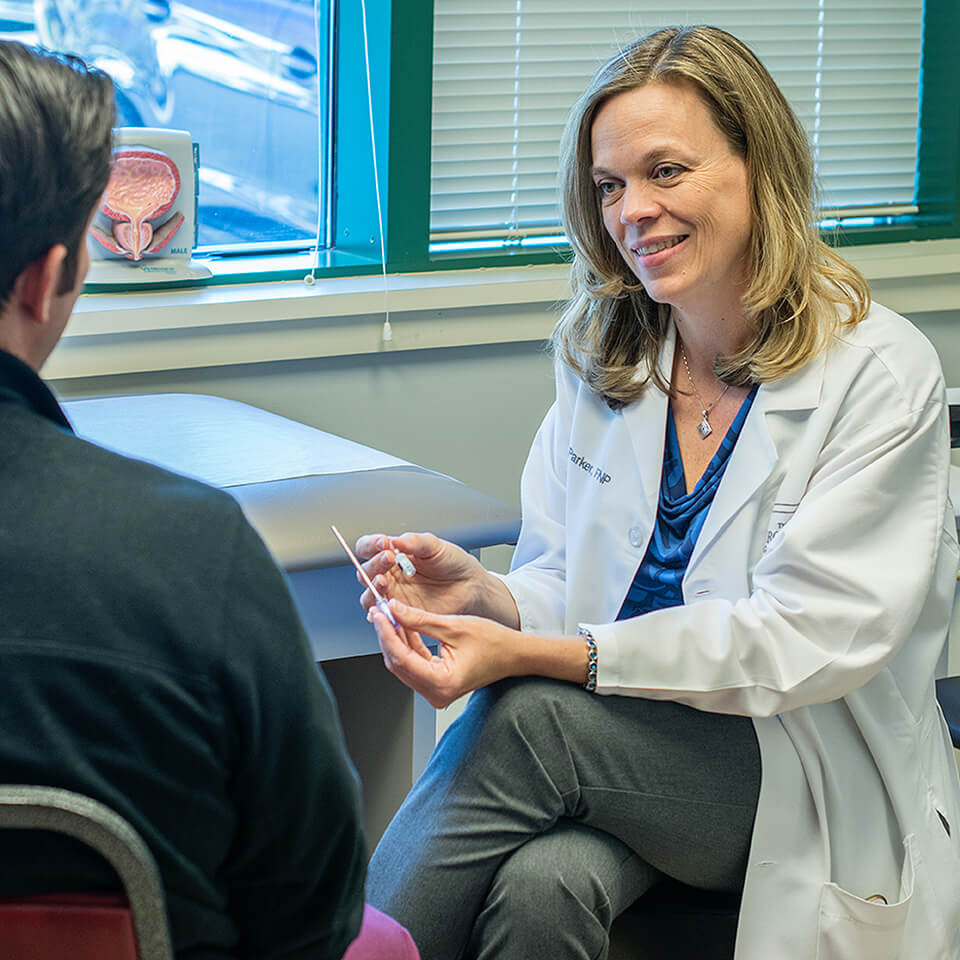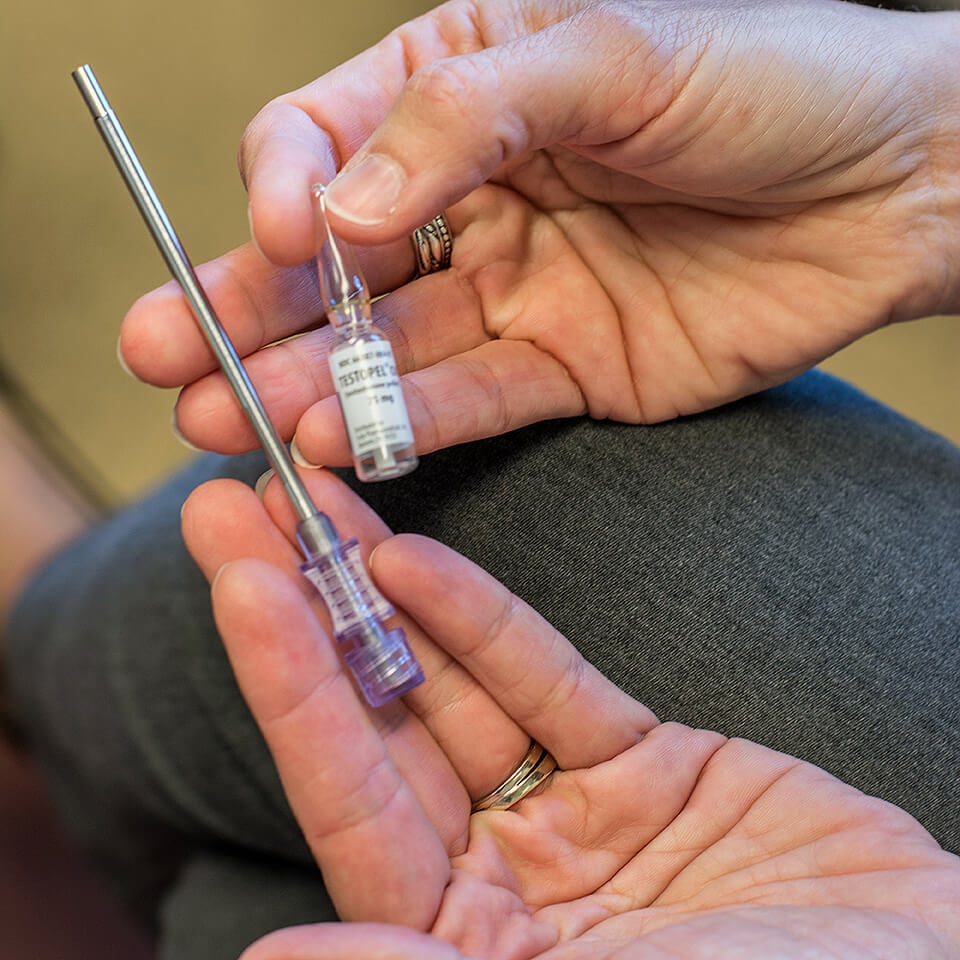Testosterone Replacement Therapy
A low level of testosterone is a common problem. Current estimates suggest that as many as one in 10 men between the ages of 40-60 and two in 10 men over the age of 60 have low levels of testosterone.

Where is testosterone made?
Testosterone, the male hormone, is made in the testicle.
The testicle has two functions.
First, it makes sperm which is carried from the testicle through the vas deferens tube to mix with fluid from the seminal vesicle and prostate to form the semen, which is the fluid that comes out at the time of ejaculation.
Second it makes testosterone, the male hormone, which is carried from the testicle by the bloodstream to reach its different target sites.
Testosterone production by the testicle is in turn controlled by a gland in the brain, which is known as the pituitary gland. The pituitary makes a hormone known as luteinizing hormone (LH), which controls the level of testosterone production. A feedback mechanism exists. The pituitary senses how much testosterone is present in the body and either increases or decreases the level of LH production to regulate the level of testosterone.
What does testosterone do?
Testosterone is responsible for the changes which take place during puberty, including development of facial hair, muscle mass, deepening of the voice, and development of the sexual organs. In adults, testosterone is necessary to maintain sexual function and keep both bones and muscles healthy. Testosterone level may become low due to diminished function of the testicle or of the pituitary gland, or in some men, may be a normal change that takes place with aging.
What are the signs of Low T?
A variety of signs and symptoms may be associated with low testosterone level, including low sex drive, decreased erectile function (ED), reduced muscle mass and strength, decreased bone density (which can lead to an increased risk of fracture), difficulty concentrating, depression and fatigue.
The best way to determine if testosterone is low is with a blood test that measures the total testosterone level.
What are the benefits and risks of Testosterone Replacement Therapy (TRT)?
If the testosterone level is low, there are a variety of potential benefits which may occur with testosterone replacement, which can include enhanced energy level and mood, an increase in lean body mass and muscle strength, a decrease in total body fat, improvement in sexual drive and erectile function, and an increase in bone mineral density which may lead to reduced fracture risk.
In addition to the benefits which may occur, there may also be possible risks associated with testosterone replacement, which can include sleep disturbances in the form of sleep apnea in men who are overweight or who have lung disease, an increase in red blood cell count (which can be a health benefit if the blood count is low or a health risk if the blood count is high), an elevation of blood cholesterol, and an increase in prostate size.
Testosterone replacement therapy does not cause prostate cancer, and clinical data shows no relationship between testosterone level and prostate cancer risk. Men who are on testosterone replacement therapy need regular examinations of the prostate, which should include a digital rectal exam and a PSA blood test. Of note, testosterone replacement therapy is not indicated for men with existing prostate cancer, and it may accelerate the growth of prostate cancer if it is already present.
Testosterone replacement therapy may also stimulate benign prostate growth. All men are at risk for benign or noncancerous enlargement of the prostate which develops starting at age 40. Testosterone replacement therapy may increase the rate of this age-related growth.
If the testosterone level is normal, there is no advantage to giving extra testosterone. Due to the feedback control system which exists, if extra testosterone is given from an outside source, the body will then make less of its own testosterone.
What forms of TRT are available?
There are several ways to replace testosterone, including the use of a gel, a patch, injection or long-acting pellets placed under the skin.
Testosterone replacement gels are applied once daily to the upper arms, shoulders, or abdomen. This quick drying formula is absorbed by the skin which releases testosterone into the bloodstream. Contact with others should be avoided until the gel has dried.
Testosterone replacement is also available in a patch form. Patches are worn for 24 hours and changed daily. The patch can be applied to the upper arms, thigh, back, or abdomen. In some patients, there may be potential skin irritation which can develop at the site of patch placement. The gel or patch provides a steady state release of the testosterone which produces a stable testosterone level.
Testosterone can also be given in the form of injection, which is either self-administered or given through the doctor’s office at regular intervals. With injection therapy, there is an initial absorption which leads to a peak testosterone level three days after injection which then slowly declines over time. Fluctuations in testosterone level are more likely to occur with injection technique rather than with the gel or patch.

TRT – not for everybody…
It should be noted that while testosterone replacement therapy can provide health benefits for men with low testosterone, it does not reverse the aging process. As such, patients should be wary of over-the- counter herbal or testosterone-like supplements which are not approved by the FDA and whose effects are unproven.
Take Home Message
Low testosterone level is a common problem. In appropriate patients, testosterone replacement can provide favorable health benefits.
Additional Information
Contact us to request an appointment or ask a question. We're here for you.




